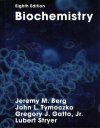About this book
For four decades, this extraordinary textbook played an pivotal role in the way biochemistry is taught, offering exceptionally clear writing, innovative graphics, coverage of the latest research techniques and advances, and a signature emphasis on physiological and medical relevance. Those defining features are at the heart of this edition.
New to this edition:
- New Case Studies
- With these assignable and assessable biochemistry case studies, students work with data, develop critical thinking skills, connect topics and apply what they’re learning to real scenarios. Cases include suggestions for using them in the classroom and aligned assessment questions for quizzes and exams.NEW Clicker Questions (Microsoft Word and PowerPoint)
- With these questions, instructors can integrate active learning in the classroom and assess students’ understanding of key concepts during lectures.
New Coauthor, Gregory J. Gatto, Jr.
A longtime contributor to the text, Gatto has made major contributions throughout the new edition, leading the revision of:
Chapter 2. Protein Composition and Structure
Chapter 3. Exploring Proteins and Proteomes
Chapter 5. Exploring Genes and Genomes
Chapter 6. Exploring Evolution and Bioinformatics
Chapter 7. Hemoglobin: Portrait of a Protein in Action
Chapter 12. Lipids and Cell Membranes
Chapter 13. Membrane Channels and Pumps
Chapter 14. Signal-Transduction Pathways
Chapter 34. The Immune System
Chapter 36 Drug Development
Contents
Content Update Highlights
Chapter 5 Exploring Genes and Genomes
Expanded coverage on Mass Spectrometry, Protein Mass, Protein Identity and Protein Sequence
Chapter 9 Catalytic Strategies
New section on “Mutations in Genes Encoding Hemoglobin Subunits Can Result in Disease”
New Clinical Insight “Thalassemia is caused by an imbalanced production of hemoglobin chains”
Chapter 13 Membrane Channels and Pumps
New Clinical Insight “Mutations in Protein Kinase A Can Cause Cushing Syndrome”
Chapter 14 Signal-Transduction Pathways
Expanded coverage in sections 14.1 & 14.2 to include:
• Most Digestive Enzymes Are Secreted as Inactive Precursors
• A new clinical insight “Protein Digestion Begins in the Stomach”
• Protein Digestion Continues in the Intestine
• A new clinical insight “Celiac Disease Results from the Inability to Properly Digest Certain Protein”
Chapter 15 Metabolism: Basic Concepts and Design
New section “Energy Is Required to Meet Three Fundamental Needs”
Expanded coverage on phosphates in biochemical processes
Chapter 16 Glycolysis and Gluconeogenesis
New Clinical Insight “Excessive fructose consumption can lead to pathological conditions”
New clinical Insight “Aerobic glycolysis is a property of rapidly growing cells”
Chapter 20 The Calvin Cycle and the Pentose Phosphate Pathway
New Clinical Insight “Loss of Iron-Sulfur Cluster Results in Friedreich’s Ataxia”
Chapter 21 Glycogen Metabolism
New Clinical Insight “ATP Synthase Can Be Regulated”
Chapter 22 Fatty Acid Metabolism
Expanded coverage on “The Activity of Chloroplast ATP Synthase Is Regulated”
Chapter 24 The Biosynthesis of Amino Acids
Expanded coverage on Phosphorylase
Chapter 26 The Biosynthesis of Membrane Lipids and Steroids
New Clinical Insight “The Pentose Phosphate Pathway Is Required For Rapid Cell Growth”
Chapter 27 The Integration of Metabolism
New Clinical Insight “Ketogenic Diets May Have Therapeutic Properties”
New Clinical Insight “Some Fatty Acids May Contribute to the Development of Pathological Conditions”
Chapter 28 DNA Replication, Repair, and Recombination
New Clinical Insight “Fatty Acid Metabolism Is Altered in Tumor Cells”
Chapter 29 RNA Synthesis and Processing
New Clinical Insight “Phosphatidylcholine Is An Abundant Phospholipid”
New Clinical Insight “Cycling of the LDL Receptor Is Regulated”
New Clinical Insight “The Clinical Management of Cholesterol Levels Can Be Understood at a Biochemical Level”
Chapter 30 Protein Synthesis
New Clinical Insight “Blood Levels of Aminotransferase Serve a Diagnostic Function”
Table of contents:
Part I THE MOLECULAR DESIGN OF LIFE
1. Biochemistry: An Evolving Science
2. Protein Composition and Structure
3. Exploring Proteins and Proteomes
4. DNA, RNA, and the Flow of Genetic Information
5. Exploring Genes and Genomes
6. Exploring Evolution and Bioinformatics
7. Hemoglobin: Portrait of a Protein in Action
8. Enzymes: Basic Concepts and Kinetics
9. Catalytic Strategies
10. Regulatory Strategies
11. Carbohydrates
12. Lipids and Cell Membranes
13. Membrane Channels and Pumps
14. Signal-Transduction Pathways
Part II TRANSDUCING AND STORING ENERGY
15. Metabolism: Basic Concepts and Design
16. Glycolysis and Gluconeogenesis
17. The Citric Acid Cycle
18. Oxidative Phosphorylation
19. The Light Reactions of Photosynthesis
20. The Calvin Cycle and the Pentose Phosphate Pathway
21. Glycogen Metabolism
22. Fatty Acid Metabolism
23. Protein Turnover and Amino Acid Catabolism
Part III SYNTHESIZING THE MOLECULES OF LIFE
24. The Biosynthesis of Amino Acids
25. Nucleotide Biosynthesis
26. The Biosynthesis of Membrane Lipids and Steroids
27. The Integration of Metabolism
28. DNA Replication, Repair, and Recombination
29. RNA Synthesis and Processing
30. Protein Synthesis
31. The Control of Gene Expression in Prokaryotes
32. The Control of Gene Expression in Eukaryotes
Part IV RESPONDING TO ENVIRONMENTAL CHANGES
33. Sensory Systems
34. The Immune System
35. Molecular Motors
36 Drug Development
Customer Reviews
Biography
Jeremy M. Berg received his B.S. and M.S. degrees in Chemistry from Stanford (where he did research with Keith Hodgson and Lubert Stryer) and his Ph.D. in Chemistry from Harvard with Richard Holm. He then completed a postdoctoral fellowship with Carl Pabo in Biophysics at Johns Hopkins University School of Medicine.
John L. Tymoczko is Towsley Professor of Biology at Carleton College, where he has taught since 1976. He currently teaches Biochemistry, the Metabolic Basis of Human Disease, Oncogenes and the Molecular Biology of Cancer, and Exercise Biochemistry and co-teaches an introductory course, Energy Flow in Biological Systems.
Gregory J. Gatto, Jr., received his A.B. degree in chemistry from Princeton University, where he worked with Martin F. Semmelhack and was awarded the Everett S. Wallis Prize in Organic Chemistry.
Lubert Stryer is Winzer Professor of Cell Biology, Emeritus, in the School of Medicine and Professor of Neurobiology, Emeritus, at Stanford University, where he has been on the faculty since 1976. He received his M.D. from Harvard Medical School.





































